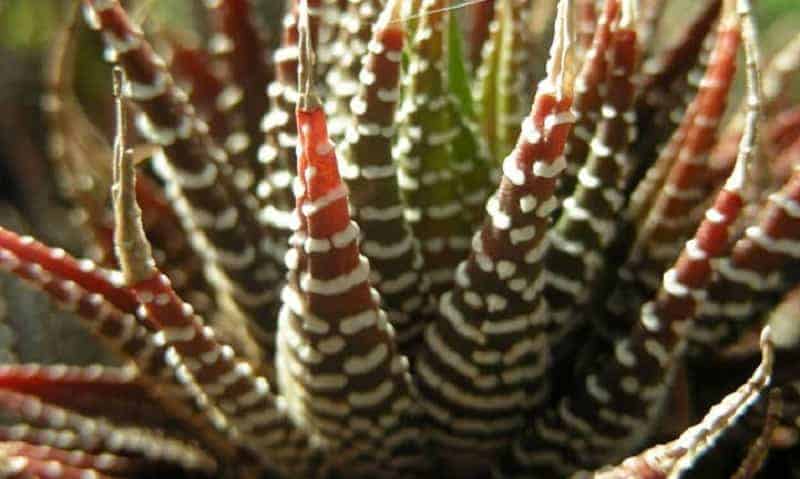Haworthia Succulent is a genus of succulents that contains approximately 150 individual species. They are members of the family Asphodelaceae, along with similar-looking plants such as Aloe and Gasteria.
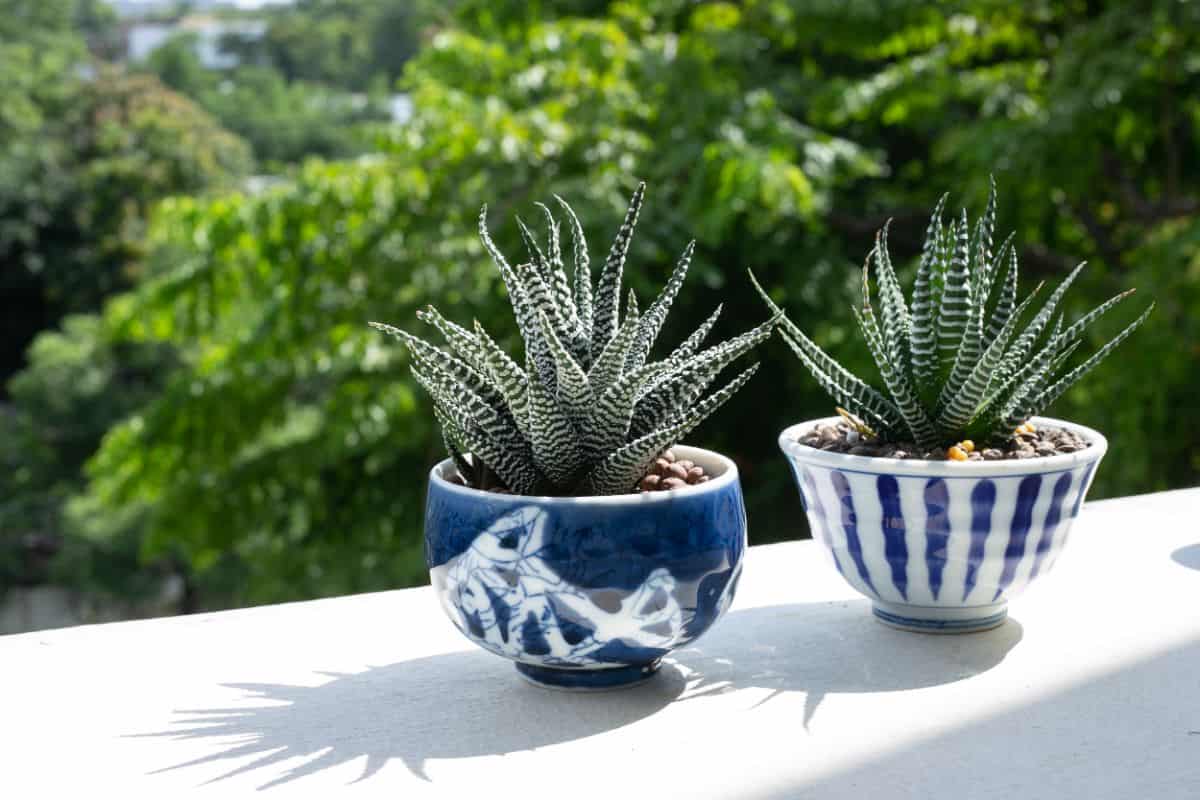
Haworthia got their name from the British botanist, entomologist, and carcinologist Adrian Hardy Haworth.
Most species of Haworthia originate in southern Africa. Most species grow naturally in the southwestern Cape, but there are some species that reach as far as Swaziland, southern Mozambique, and southern Namibia.
Recently, some species of Haworthia have been reclassified into the genera Haworthiopsis and Tulista. The classification of species isn’t an exact science, but extensive phylogenetic research contributed to this change.
Jump to:
Haworthia Appearance
| Name: | Haworthia |
| Soil: | Well-drained soil |
| Blooming: | Summer |
| Light: | Full sun to partial shade |
| Water: | When the soil is completely dry |
| Propagation: | Leaf cuttings. offsets or seeds |
Haworthia are typically either solitary or clump-forming plants that grow as stemless rosettes. Their leaves will vary in shape, color, and size according to their species. Their overall size varies between just over an inch in diameter to over 12 inches in diameter.
These plants have fleshy leaves that are most often green in color with a striped or mottled pattern. Whatever the color of the individual species, the colors may also intensify with sun stress.
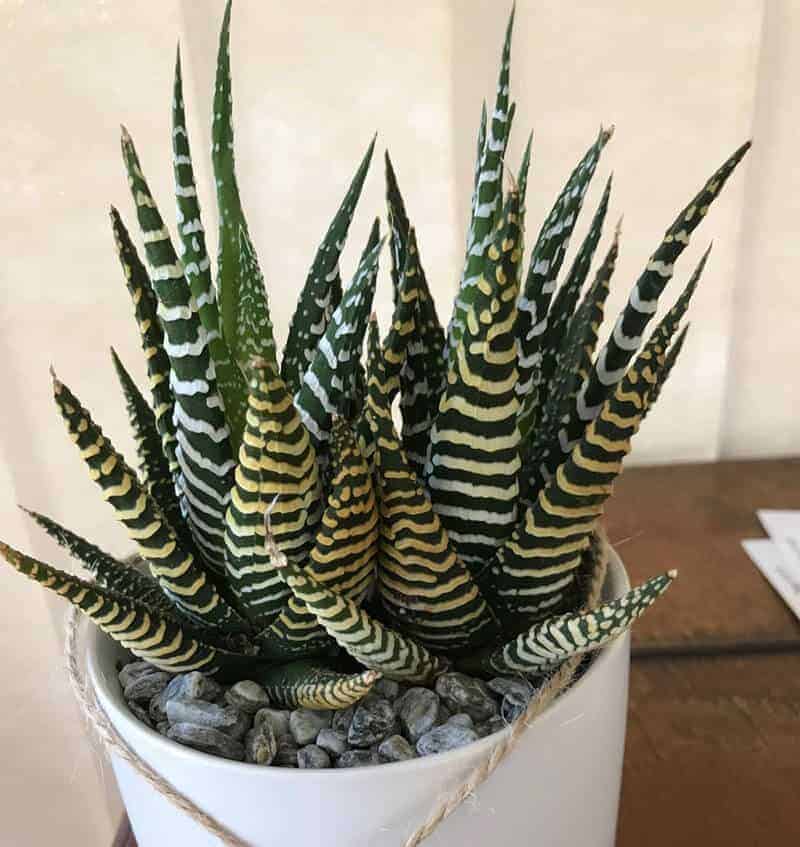
Haworthia are frequently confused with Aloe, but there are some key differences in appearance. For more details on the differences between Aloe and Haworthia, read here. It’s worth noting that these plants are similar enough to allow for hybridization, which will be discussed later on.
Unlike Aloe, Haworthia do not have teeth along their leaf margins. Though some species of Aloe lack teeth on the leaf margins as well, it is a defining feature of Haworthia.
One of the most noticeable features of Haworthia are the flowers. All species of Haworthia have similar looking flowers. They are tubular in shape with wide, open ends. They grow on slender inflorescences that remain unbranched.
The blooms tend to be rather small and are always white in color. Some species may have fain green or brown striations.
Common Species of Haworthia
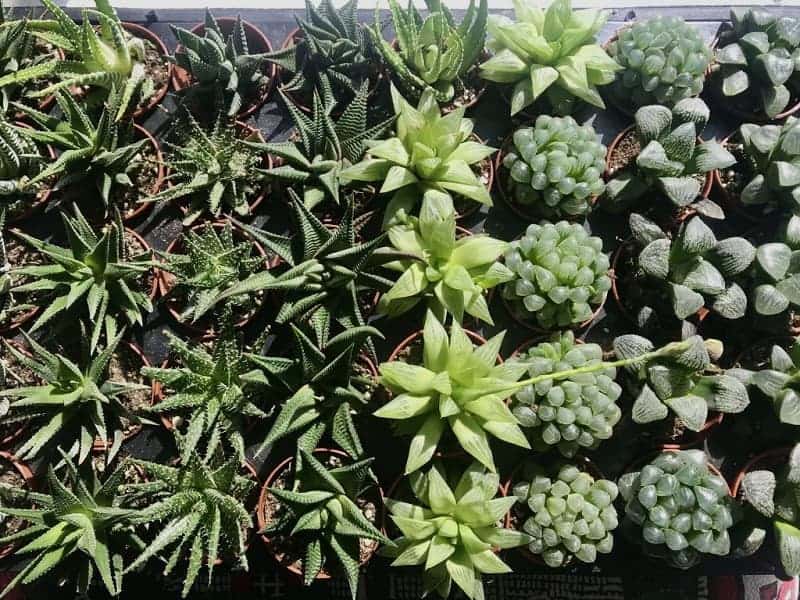
One of the most commonly seen species of Haworthia is Haworthia fasciata, also known as the zebra plant. It gets its name from the striped spiky leaves. It’s a great plant for beginner and experienced gardeners alike. It’s also non-toxic to pets, so it’s safe to have around furry friends.
A similar looking species is Haworthia attenuate, which also goes by the name zebra plant and is frequently cofused with H. fasciata. The main difference between the two species is that Haworthia attenuate has more tubercles, or warty spots, on the inner leaves.
Haworthia cooperi is another popular species of Haworthia. Rather than the long, spiky leaves of the other two species mentioned here, H. cooperi has somewhat bulbous, fleshy leaves. Its thin skin gives it a translucent appearance. The blue-green leaves also turn a coppery orange with enough sun.
See Related Article: Banana Succulent
Caring for Haworthia
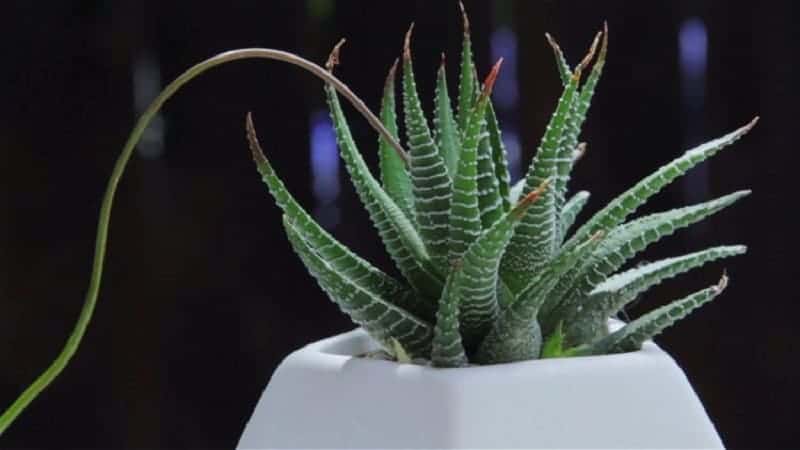
Haworthia are a common houseplant due to their low maintenance. They grow well indoors in containers, but also do well outdoors if grown in an appropriate climate.
These are great plants for beginner succulent caretakers. They are relatively forgiving and will survive most minor mistakes in care. More experienced caretakers will be able to bring out the most vibrant colors by stressing the plants a bit.
Light
The light needs of Haworthia will depend on the individual species. There are some species that thrive in full sun, but the majority of species will grow best in partial shade.
No products found.
In their natural habitat, Haworthia grow at the base of rocks and bushes, so they’re generally provided with quite a bit of natural shade.
This lower light requirement make Haworthia ideal for indoor succulent collections. Whether in a home or office, Haworthia can tolerate most low light environments well, but prolonged lack of light may weaken the plant.
When kept indoors, bright indirect light is ideal. Too much direct sunlight can result in sunburn. If a Haworthia’s leaves appear to be turning yellow or white, it’s typically a sign of too much sun.
Ideally, an east or west facing window will provide the plant with at least a few hours of bright light per day.
Haworthia grow well under artificial light, so if you don’t have the window space to accommodate this hardy plant, don’t stress.
Without enough sunlight, the leaves of a Haworthia may become pale or faded in color.
If you decide to increase your Haworthia’s light levels, be sure to do so slowly to avoid sun damage, especially if the plant has been in a relatively low light environment.
Introduce your Haworthia to more sun by slowly increasing the amount of daily light over a period of about a week or two. Slow increases reduce the risk of sunburn.
Water
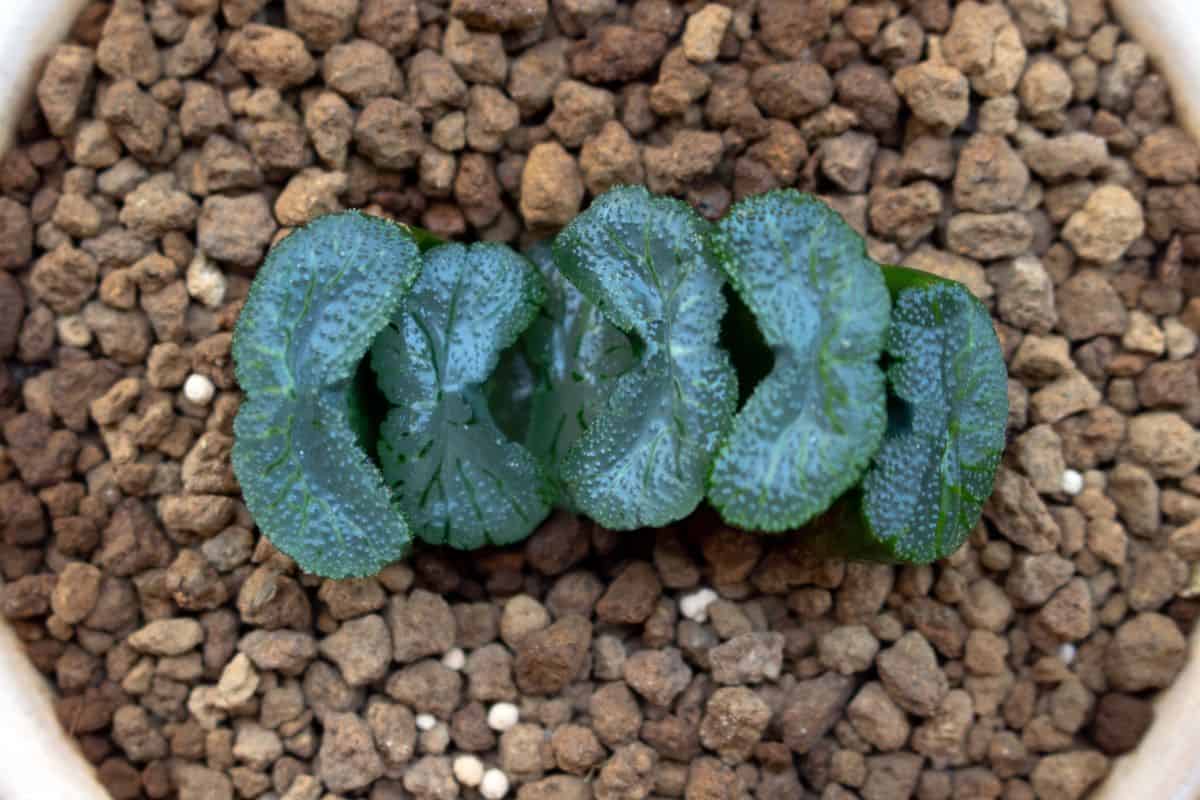
Like most succulents, Haworthia are quite tolerant of underwatering, but may not survive frequent overwatering. Standing water should be avoided at all costs, as this can lead to root rot.
Haworthia prefer to be watered deeply but infrequently. It’s recommended to allow the soil to dry out between watering.
Most species of Haworthia go dormant during the summer, so they won’t need as much water as they do during their growing season. Most species need only enough water to keep the leaves from shriveling.
However, the vast majority of succulents grown indoors do not experience a period of true dormancy as conditions are about the same all year round.
Indoor succulents do not experience the same temperature fluctuations as those grown outdoors. There may be some differences in light throughout the seasons, but with grow lights, dormancy may not occur, nor is it necessary.
If the leaves of a Haworthia appear mushy, pale, or translucent, it’s likely being overwatered. The bottom leaves of the plant will be the first to be affected, so be sure to monitor them closely if overwatering is suspected.
In some cases, it may be possible to save an overwatered Haworthia, but if overwatering has been frequent, it may be too late. Root rot is a common problem with overwatered succulents and few plants survive once they begin to rot.
Haworthia are not a succulent that need high humidity. In their natural habitat, they get by with little moisture in the air. This is not a plant that will require humidifiers or pebble trays if you live in a dry climate.
Temperature
Haworthia enjoy warm temperatures in the summer and cool temperatures in the winter, but they are not frost tolerant plants. Their ideal temperature range is between 70 and 90 degrees Fahrenheit, but they can tolerate temperatures down to about 50 degrees Fahrenheit.
The lowest temperatures that most species of Haworthia can tolerate is about 30 degrees. Some species can handle a light frost, but most will not. When in doubt, bring your Haworthia indoors or protect them from freezing.
Soil
Haworthia are drought tolerant plants that will not tolerate wet roots for prolonged periods of time. Their soil needs to be fast draining in order keep their roots happy and to prevent root rot.
In their natural habitat, Haworthia live in sandy or rocky soils, so you should do your best to simulate their preferred substrate.
Soil formulated for use with cacti will work well with Haworthia. They need soil with larger particles such as sand, perlite, gravel, pumice, or even bark.
Some gardeners recommend against fine sand, however, as it can hinder drainage and air flow between the larger particles.
If you would prefer not to use a commercial cactus mix, you can always formulate your own soil to suit your Haworthia’s needs.
Type of Container
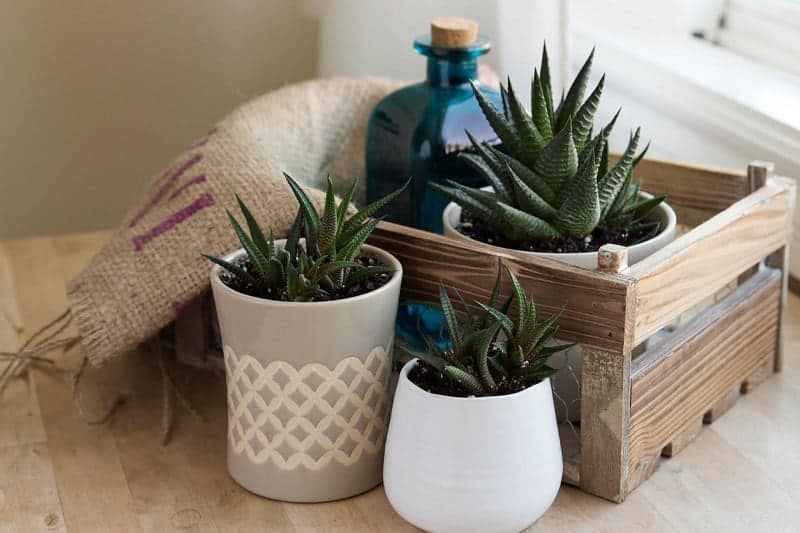
Haworthia are the perfect succulent for most container gardens. They’re hardy and require little care as long as they’re planted in the right kind of pot.
The most important feature in any pot destined for use with Haworthia is a drainage hole. Though it may be possible to keep a succulent alive in a container with no drainage holes, it’s not recommended.
Without drainage holes, you’ll need to provide your Haworthia with the perfect watering schedule, which can be quite difficult for most gardeners.
Instead of risking your precious plant’s life, it’s best to use the right kind of container. After all, there’s little point to planting your Haworthia in fast draining soil if the excess water doesn’t have anywhere to go.
Since Haworthia are relatively small succulents that grow quite slowly, they don’t need a lot of space. The species that grow in clumps will do well in wide shallow containers..
There are some species of Haworthia, however, that grow larger deeper root systems, so they may do better with a slightly deeper container. These plants usually have deep feeding roots along with shallow surface roots to maximize their absorption.
Although you don’t want to plant your Haworthia in a container that is too large, you also want to give them enough space for good root development.
Since Haworthia are slow growing succulents, you likely won’t need to repot them frequently. If they outgrow their container or are in need of fresh soil, the best time for repotting is in the spring or early summer.
Propagating Haworthia
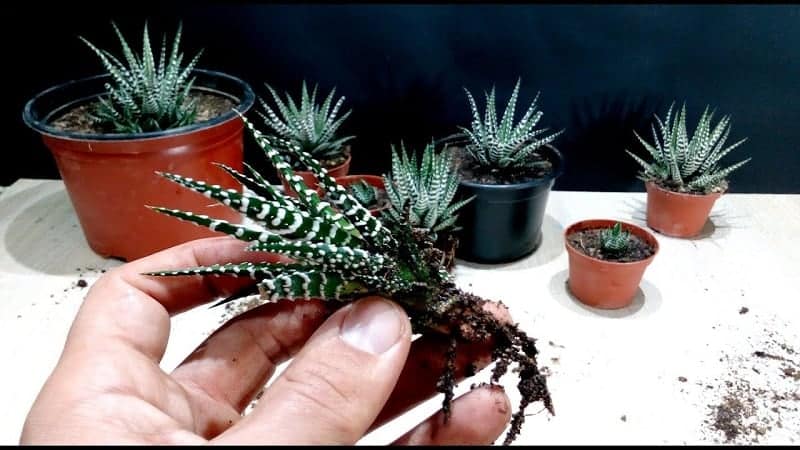
There are three methods of successful Haworthia propagation: offset division, leaf cuttings, and seeds. By far, the easiest method of propagation is offset division, but if you’re up for some experimentation, the other methods will also give you new Haworthia at little to no cost to you.
Offsets
Clumping species of Haworthia will produce plenty of baby plants in clumps surrounding the mother plant. These are most easily be separated during repotting, but with a little effort they can also be separating at any time of the year.
To remove an offset from the mother plant, you’ll need to cut it away as close to the mother plant as possible. Use sharp, sterile shears, scissors, or a knife for the best results. Try to include as many of the offset’s roots as possible.
It’s recommended to allow the offsets to dry for a few days before planting to allow the cuts to callous. This will help prevent any infection by fungus or bacteria in the new plantlets.
Once the offsets have calloused, you can plant them in a new container and water as sparingly as you would a fully mature Haworthia.
This is the easiest way to propagate Haworthia because you’re essentially working with fully formed plants that simply need transplanted to their own container. Cheap gifts for friends and family, anyone?
Cuttings
Haworthia can also be propagated with leaf cuttings, but this is definitely a more time-consuming method of gaining new plants. However, if you’re ready for a challenge, don’t be afraid to give it a shot.
It’s also worth noting that some species do better with leaf cuttings than others, so if you want a surefire method of propagation, it may be best to stick with offset division.
When taking Haworthia cuttings, its generally recommended to use a sharp knife rather than a pair of shears or scissors. With the tight rosette of this plant, it can be difficult to cut out a healthy young leaf with a bulky tool, so it’s best to use something simpler.
Some gardeners advise against taking older leaves around the bottom of the plant as they don’t always root as well as the younger leaves near the top.
After you take your cuttings, you need to let them dry to allow the cuts to callous. Again, this is to protect the cuttings from any potential pathogens that could enter through the wound.
If you’d like to encourage faster rooting, you can also dip the cutting into rooting hormone, but it isn’t a necessary step. If you do use rooting hormone, it helps to moisten the cutting before dipping to help the powder stick to the plant better.
Once the cutting has calloused and after you apply rooting hormone if you choose, you can place the cutting in a new pot with well-draining soil.
As you wait for your cutting to grow roots, it’s best to keep the leaf out of direct sunlight. Bright, indirect light is best. Some gardeners recommend keeping the soil moist, but until your cutting has roots, it can’t really absorb moisture anyway.
After a few weeks, new roots should appear. It may take several more weeks before you see a tiny rosette beginning to form at the base of the cutting.
Seeds
Though it’s not common to grow succulents with seeds, it is possible to propagate Haworthia in this manner. This is not a propagation method for impatient gardeners!
Seeds should be sown in either spring or fall in Haworthia’s preferred well-draining soil mix. After sowing the seeds, the soil should be kept moist until the seeds germinate, which can take up to a few weeks.
Remember, Haworthia are not a fast-growing plant, so don’t expect to have a new collection of plants anytime soon.
Your new Haworthia seedlings may not actually be big enough to transplant until after their first year or two of growth.
Haworthia Hybrids
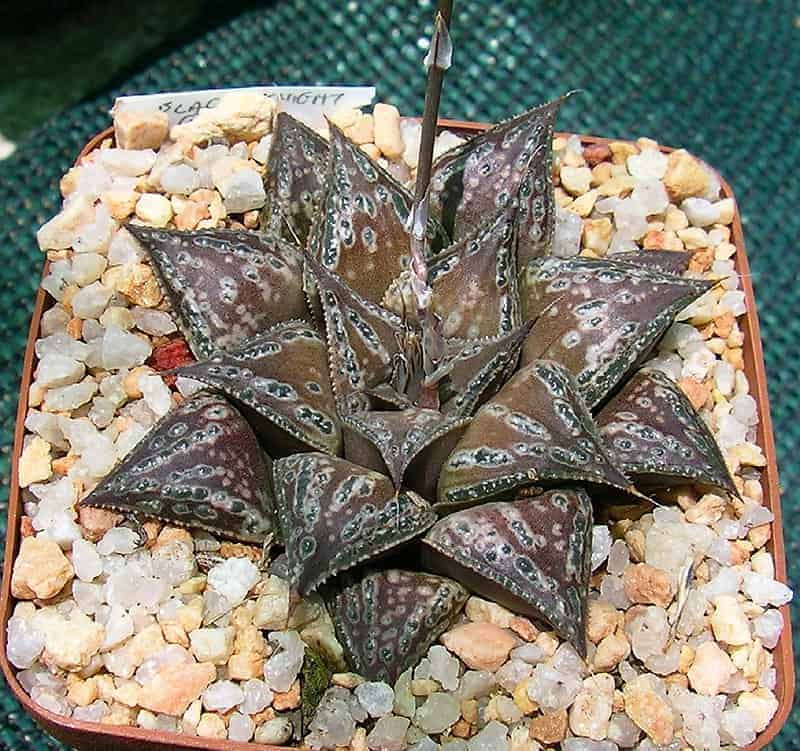
Haworthia are unable to reproduce asexually except with offsets and cuttings. It is not possible for this plant to produce seeds without the help of another genetically different plant. For this reason, it is quite easy to hybridize Haworthia.
Haworthia species are similar enough genetically to be hybridized, resulting in new and unique species of Haworthia, such as Haworthia ‘Harry Johnson’ or this Haworthia obtuse hybrid.
It’s also possible to cross Haworthia with other species of succulents such as Graptoveria and Aloe. Examples of resulting hybrids include x Gasterhaworthia ‘Rosava’ and x Alworthia ‘Black Gem’.
Caring for hybrids is as simple as caring for the plants used to create them, so if you can keep a Haworthia alive, a Gasterhaworthia or Alworthia should be no different.
Haworthia is considered relatively healthy plants with few serious pest problems. If you haven’t yet encountered any common pests, you should consider yourself lucky, but even though Haworthia are pretty hardy in terms of pests, it’s still best to practice good plant hygiene and proper watering techniques.
To prevent pests, always quarantine new plants for at least two weeks in an area away from your main succulent collection. This should give your new Haworthia enough time for any problems to appear so that you can treat it before exposing your other plants.
It’s crucial to keep your Haworthia’s container clean and free from dead leaves, flowers, or other plant material. These items will only decay, which can lead to a variety of problems including a potential fungus gnat infestation.
Mealybugs, scale, and spider mites can spread quickly through your garden and take weeks or even months to eliminate, so it’s best to prevent the problem from spreading if possible.
If you can keep your plant's pest free, the only problem you really need to worry about with your Haworthia is making sure you’re watering it correctly.
Remember, overwatering is the most common reason for Haworthia deaths, so make sure the soil gets a chance to thoroughly dry out between watering. This will prevent deadly root rot from developing.
You Might Also Like:
- 7 Best Places to Buy Succulents Online
- The Complete Guide to Grow Lights for Succulents
- 7 Best Succulent and Cactus Soils
- Best Indoor, Low-Light Succulents
Sources:
- https://mastergardener.extension.wisc.edu/article/haworthias-super-succulents-for-small-spaces/
- https://keys.lucidcentral.org/keys/v3/South_African_Plant_Families/key/South%20African%20Plant%20Families/Media/Html/Asphodelaceae.htm
- https://www.plantsoftheworldonline.org/taxon/urn:lsid:ipni.org:names:60006629-3


